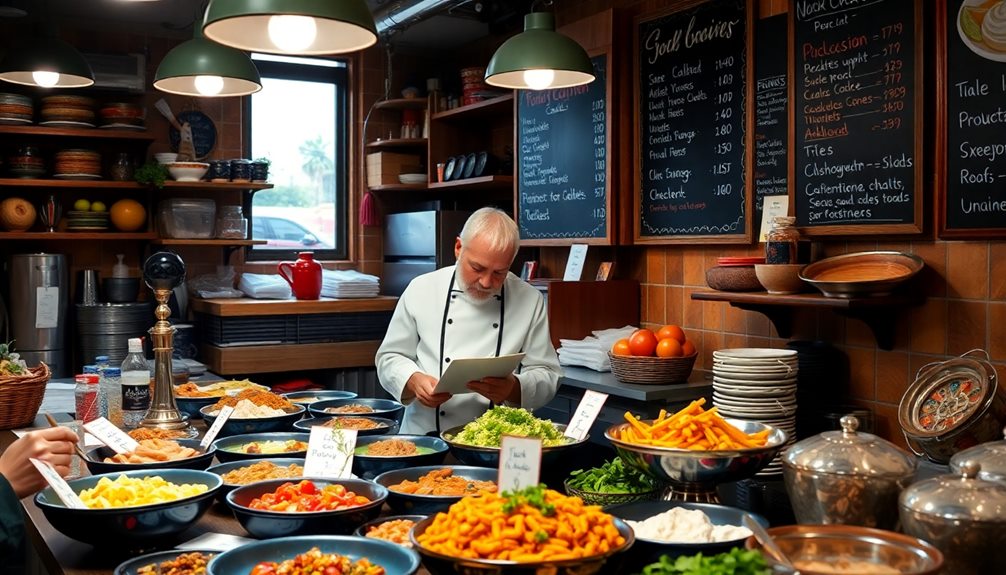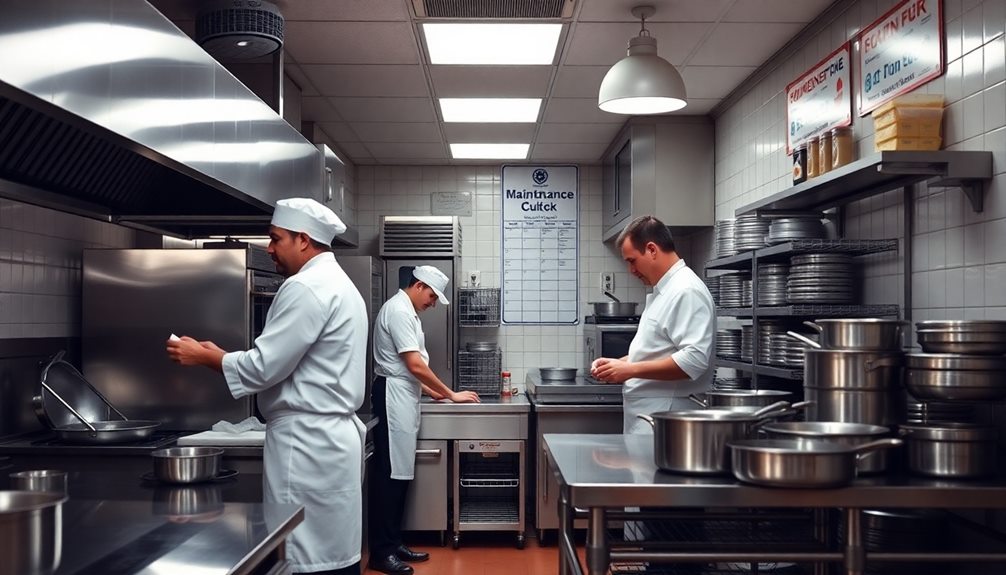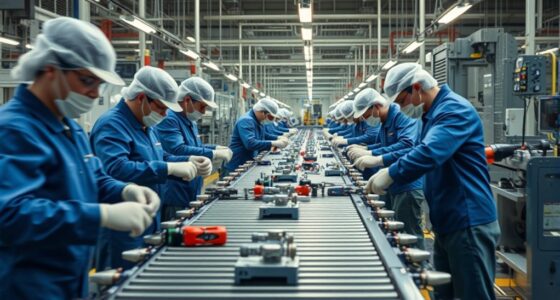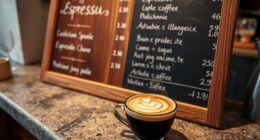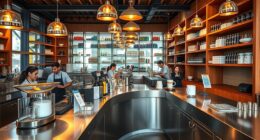Restaurants price their menu items by analyzing food costs, setting ideal profit margins, and considering local market rates. To maintain profitability, they generally aim for a food cost percentage of 28-35%. They might highlight high-margin dishes to boost revenue and apply psychological pricing strategies, like ending prices with .99, to enhance sales. Competitive analysis also plays a key role, ensuring prices align with similar establishments in the area. By understanding their target audience and constantly reviewing costs, restaurants adjust their strategies effectively. Curious about the specific techniques they use? You'll discover even more insights further along.
Key Takeaways
- Restaurants aim for a food cost percentage of 28-35% to balance profitability and customer satisfaction.
- Menu prices are determined by calculating the raw food cost and applying desired profit margins.
- Competitive analysis ensures menu prices are aligned with local market rates and customer expectations.
- Psychological pricing techniques, such as charm pricing and strategic placement, can influence customer purchasing decisions.
- Regular menu reviews and adjustments are necessary to adapt to fluctuating ingredient costs and market trends.
Overview of Menu Pricing Strategies
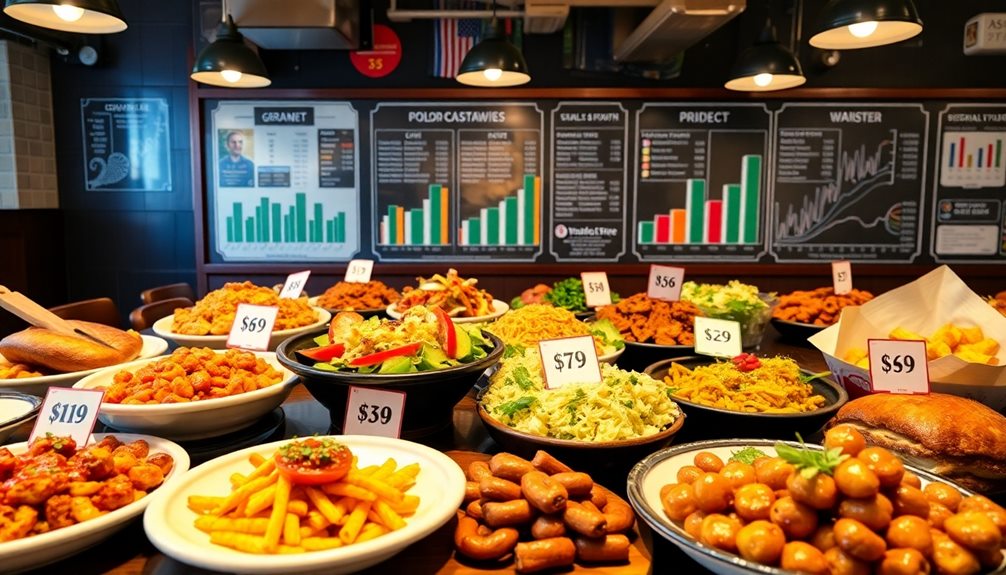
Understanding menu pricing strategies is vital for any restaurant looking to balance profitability with customer satisfaction. You need to focus on food cost percentages, aiming for that ideal range of 28-35% to guarantee your expenses don't eat away at your profits. By analyzing these percentages, you can set prices that not only cover costs but also appeal to your customers.
It's essential to take into account gross profit margins in your strategy. High-margin items should be highlighted on your menu, allowing you to maximize revenue while minimizing waste. Conducting a competitive analysis helps you understand local market rates, making sure your pricing aligns with consumer expectations. This way, you remain attractive to potential customers while still achieving your financial goals.
Don't forget the psychological aspects of menu design; strategic placement and wording can influence purchasing decisions.
Regularly review and adjust your menu prices to adapt to fluctuating ingredient costs and changing consumer demands. By staying proactive in your approach, you can refine your menu pricing strategies, boost profitability, and maintain customer satisfaction, creating a win-win scenario for your restaurant.
Calculating Food Costs
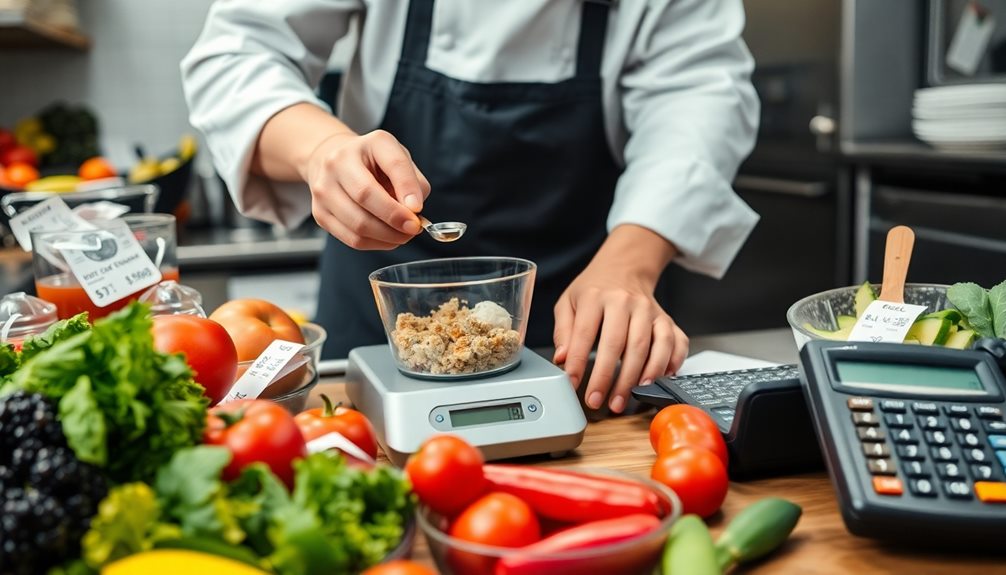
Calculating food costs accurately is key to maintaining profitability in your restaurant. To do this, you need to determine the total cost of raw ingredients for each menu item while factoring in yield and waste. This will help you establish the true plate cost.
The ideal food cost percentage for most restaurants typically ranges between 28% and 35%. Keeping this in mind will guide your pricing strategies.
To calculate food cost percentage, use the formula:
Food Cost Percentage = (Food Costs / Sales) x 100.
This will show you what portion of your revenue is spent on food and beverages.
Regularly evaluating your cost of goods sold (COGS) is also essential. You can calculate COGS using the formula:
COGS = Beginning Inventory + Purchases – Ending Inventory.
Understanding Profit Margins

Profit margins are essential to a restaurant's financial success, directly impacting your ability to cover costs and generate income.
To achieve sustainable profit, you need to understand key components like the ideal food cost percentage and gross profit margin. Here's how these elements fit together:
- Ideal Food Cost Percentage: Aim for a range between 28% to 35%, ensuring you balance quality and profitability.
- Gross Profit Margin: Target a margin between 40% to 70%, which indicates the revenue after covering the cost of goods sold. This is vital for your restaurant's financial health.
- Menu Pricing Calculation: Use the formula Price = Raw Food Cost / Ideal Food Cost Percentage to determine your menu prices effectively.
Pricing Strategies for Restaurants
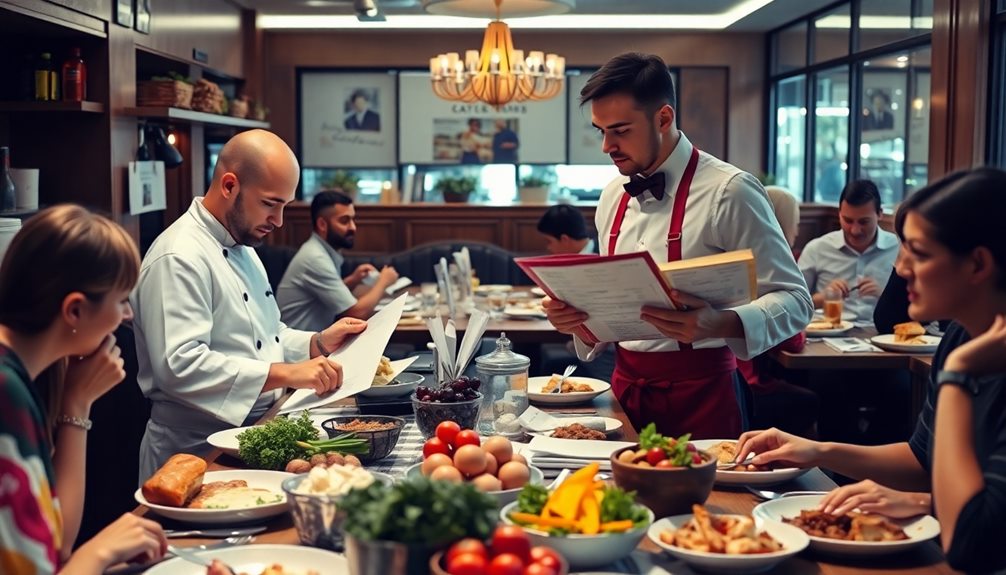
When pricing your menu items, you'll want to take into account various strategies that align with your restaurant's goals.
The food cost method helps you maintain a healthy profit margin, while the gross profit approach guarantees each dish contributes to your bottom line.
Additionally, competitive pricing strategies allow you to stay relevant in your market by adjusting your prices based on what similar restaurants are charging.
Food Cost Method
How can restaurants effectively set menu prices while ensuring profitability? One popular approach is the food cost method. This strategy targets an ideal food cost percentage, usually between 28% to 35%, which helps you determine menu prices based on raw material costs.
Here's how you can implement this method:
- Calculate Raw Food Cost: Start with the cost of ingredients for each dish.
- Determine Ideal Food Cost Percentage: Choose a target percentage (e.g., 30%).
- Set Menu Price: Use the formula Price = Raw Food Cost / Ideal Food Cost Percentage. For example, if a dish costs $4.00 to make and you want a 30% food cost, the price would be around $13.33.
Don't forget to round the price to something more appealing, like $13.29.
Regularly reviewing and adjusting your prices is essential due to fluctuations in raw material costs. By using the food cost method, you can effectively implement menu pricing strategies that keep your restaurant profitable while still attracting customers. Regular price evaluations ensure that you maintain a balance between covering expenses and offering value to your customers. Additionally, pairing smart pricing strategies with efforts to optimize portion sizes and inventory management can contribute to how restaurants reduce food waste. This not only enhances profit margins but also promotes sustainability, resonating with increasingly eco-conscious diners.
Gross Profit Approach
Setting menu prices effectively is vital for restaurant success, and one powerful strategy is the Gross Profit Approach. This method focuses on setting prices based on your desired gross profit margin, typically around 60-70%. This guarantees your sales exceed the raw food cost, allowing for better profitability.
To calculate your menu price using this approach, you can apply the formula:
Menu Price = Raw Food Cost / (1 – Desired Gross Profit Margin)
Here's a quick example to illustrate:
| Raw Food Cost | Desired Gross Profit Margin | Menu Price |
|---|---|---|
| $5 | 70% | $16.67 |
| $7 | 70% | $23.33 |
| $10 | 60% | $25.00 |
| $8 | 65% | $22.86 |
| $12 | 60% | $30.00 |
Regularly reviewing your menu prices against this target gross profit margin helps maintain profitability. This balance is essential, as high gross profit margins greatly contribute to your restaurant's overall financial health while still appealing to customers.
Competitive Pricing Strategies
Understanding competitive pricing strategies is key to maximizing your restaurant's profitability while attracting customers.
By analyzing local market prices, you can effectively match, underprice, or set premium prices based on what sets your restaurant apart. Here are three essential approaches you can adopt:
- Demand-Driven Pricing: Raise your prices during peak times for popular items, capitalizing on customers' willingness to pay more when demand is high.
- Cost-Plus Pricing: Calculate your total production costs for each menu item and add a markup percentage. This method keeps your prices competitive while ensuring profitability.
- Value-Based Pricing: Set prices according to the perceived value of your dishes, ambiance, and quality of service. This approach allows you to justify higher prices compared to competitors.
Regularly conducting competitive analysis is vital to adjust your pricing strategy in response to market trends.
Psychological Pricing Techniques
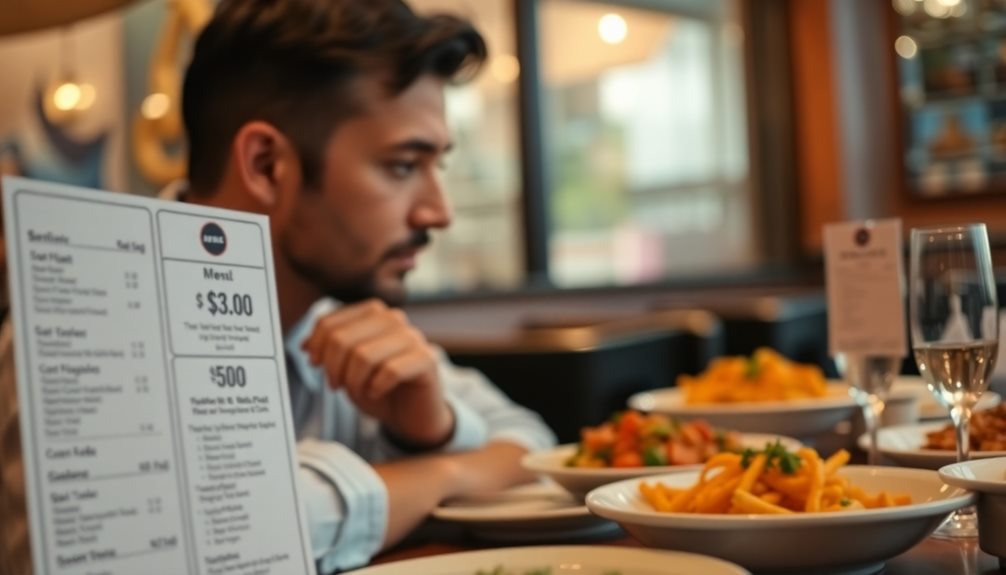
When you're pricing your menu items, using psychological pricing techniques can make a big difference.
For instance, charm pricing, where you set prices just below a whole number, can make dishes feel more affordable.
Pair that with strategic visual placement and descriptive language, and you've got a recipe for boosting sales and enticing customers.
Charm Pricing Strategy
Charm pricing is a powerful psychological pricing technique that can greatly influence how customers perceive the value of menu items. By setting prices just below a round number—like pricing an item at $9.99 instead of $10—you make it appear markedly cheaper. This technique taps into menu psychology, impacting purchasing decisions even with minimal price differences.
Understanding common financial terms can further enhance your pricing strategy by ensuring that you communicate value effectively.
Here are three key benefits of charm pricing in your menu strategy:
- Enhanced Perception: Prices ending in .99 or .95 are often seen as better deals, boosting sales compared to rounded prices.
- Increased Revenue: By encouraging more purchases, charm pricing helps maximize revenue, especially for high-margin items that diners are likely to choose.
- Attractive Presentation: Left-aligned pricing on menus tends to draw more attention, enhancing the charm pricing effect.
Combining charm pricing with descriptive language for high-margin items creates an enticing experience that can lead diners to select those options.
Ultimately, implementing charm pricing can greatly elevate your restaurant's sales while enhancing customer satisfaction.
Visual Price Placement
Positioning prices effectively on your menu can greatly impact how diners perceive and decide on their meal choices. Visual price placement plays a significant role in menu psychology, as the way you arrange prices can guide customer behavior. For instance, placing prices on the left side of the menu tends to enhance perception, making it easier for diners to process the information.
Utilizing the Golden Triangle concept, you should position your high-profit items at the top and bottom of each section. This technique captures attention and increases the likelihood of sales. Highlighting chef's specials or signature dishes with borders or graphics can also make these price menu items stand out, steering customers toward more expensive options.
Additionally, implementing charm pricing—like $9.99 instead of $10.00—can subtly influence how customers perceive value and boost purchase rates.
By crafting a visually appealing menu that employs these strategies, you can create an engaging dining experience while maximizing your profits.
Descriptive Language Impact
Effective menu design goes beyond visual placement; the language you use can dramatically influence customer choices. Descriptive language enhances perceived value, making your higher-margin dishes more enticing. By painting a vivid picture, you can guide customers toward selecting those premium items.
Here are three ways you can leverage descriptive language:
- Use Sensory Words: Words like "succulent," "crispy," or "zesty" engage customers' senses, making them crave the dish.
- Highlight Exclusivity: Terms such as "handcrafted," "locally sourced," or "artisanal" create a sense of uniqueness, justifying a higher price.
- Incorporate Imagery: Describing a dish's preparation or origin can evoke emotions, enhancing the overall dining experience.
Combining these strategies with psychological pricing techniques, like using prices that end in .99, can further encourage purchases by making these items appear more affordable.
Tools for Menu Management
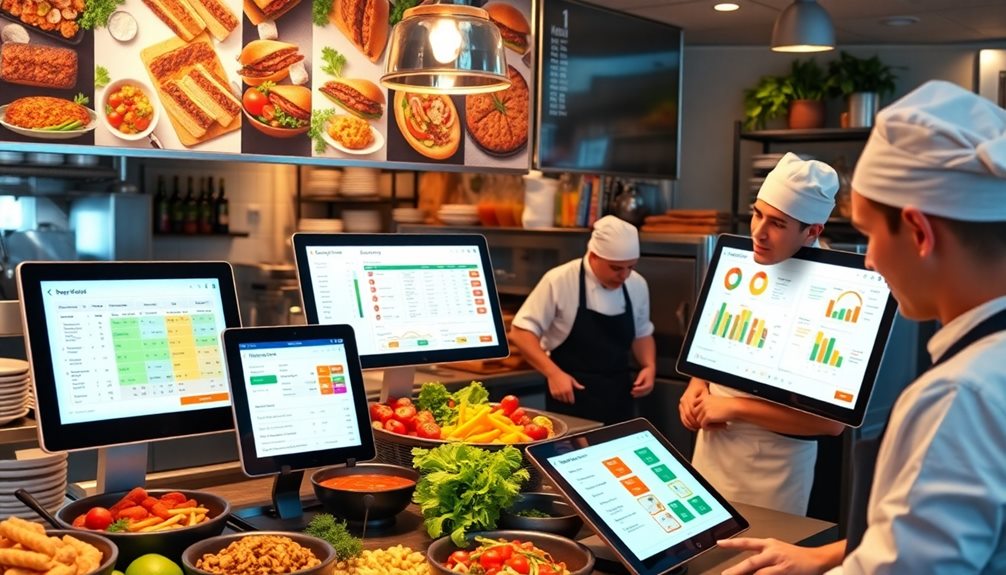
In today's competitive restaurant landscape, utilizing the right tools for menu management can make all the difference in maintaining profitability and customer satisfaction. Tools like WebstaurantPlus allow you to buy ingredients in bulk, which can greatly lower costs and enhance your menu pricing strategies.
With Recipe Resizer, you can easily adjust ingredient quantities, guaranteeing your menu items remain profitable even as food prices fluctuate.
Effective inventory management is essential, and mobile apps can help streamline your ordering processes and track ingredients in real-time. This way, you'll know exactly where your costs stand, helping you maintain food cost percentages that work for your bottom line.
Moreover, access to analytics tools can reveal valuable insights into sales trends. By understanding customer preferences and market dynamics, you can make informed pricing decisions that keep your offerings appealing.
Regular menu reviews, supported by these management tools, allow you to adapt to changing trends and optimize your pricing. By leveraging these resources, you can make certain your restaurant stays competitive and profitable in an ever-evolving market.
Terminology in Menu Pricing
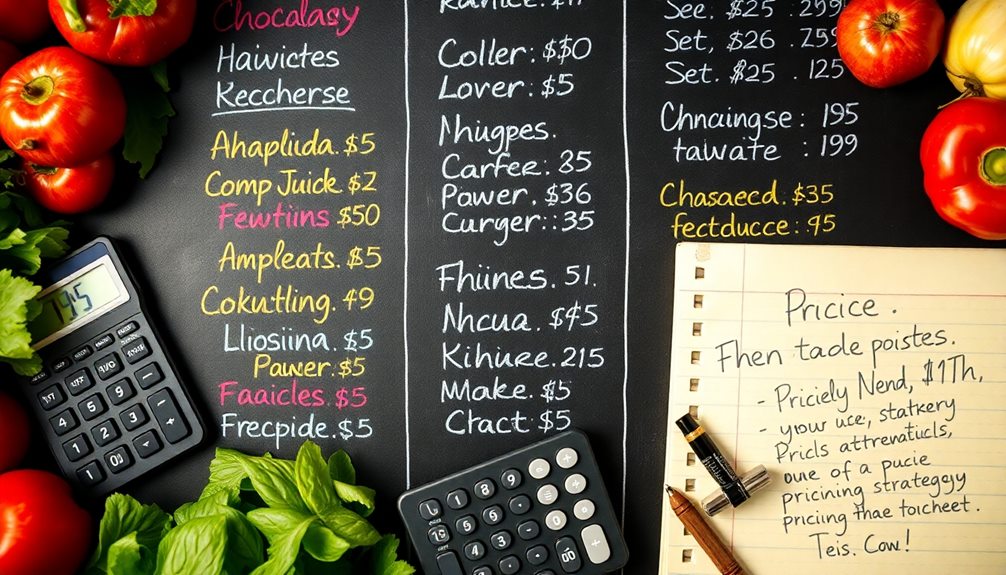
Understanding terminology in menu pricing is essential for creating a successful pricing strategy. Familiarizing yourself with key terms will help you navigate the complexities of cost management and profitability.
Here are three important concepts to grasp:
- Direct Costs: These are expenses tied directly to food purchases, like raw materials. You need to calculate these accurately to inform your menu pricing.
- Allowable Food Cost: This percentage helps you determine how much of your revenue can go towards food expenses. You calculate it by subtracting labor, overhead, and profit goals from 100%.
- Gross Profit Margin Formula: This formula helps you measure profitability by calculating the difference between your sales and the cost of goods sold. Knowing how to apply this is essential for evaluating each dish's financial performance.
Benefits and Drawbacks of Pricing Methods
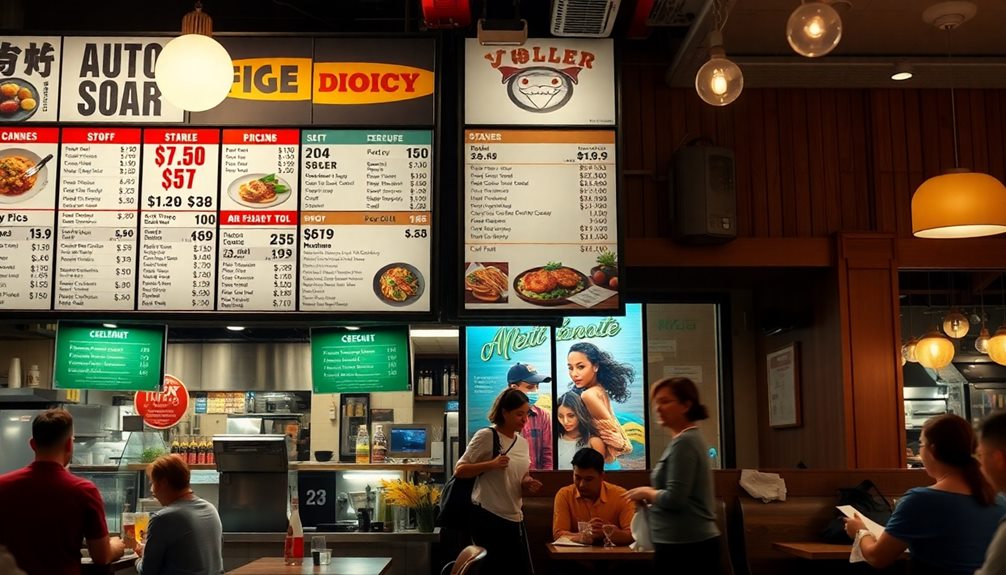
When considering various pricing methods for menu items, it's crucial to weigh both benefits and drawbacks to find the right fit for your restaurant.
The food cost method is simple and effective, allowing you to calculate prices based on raw material costs, typically aiming for an ideal food cost percentage of 28-35% for profitability. However, it may not account for market conditions or competitor pricing, which can leave you vulnerable.
On the other hand, the gross profit method can lead to higher menu prices, but it requires careful analysis of operational costs to prevent overpricing and losing your competitive edge.
Dynamic pricing adapts to demand fluctuations, offering flexibility, but it might confuse customers if not communicated clearly.
Psychological pricing techniques, like charm pricing, can effectively influence customer behavior, but relying too heavily on this strategy might overlook the importance of perceived value and quality.
Ultimately, your menu pricing strategy should balance these benefits and drawbacks to create a pricing approach that aligns with your restaurant's goals and customer expectations.
Factors Influencing Menu Prices
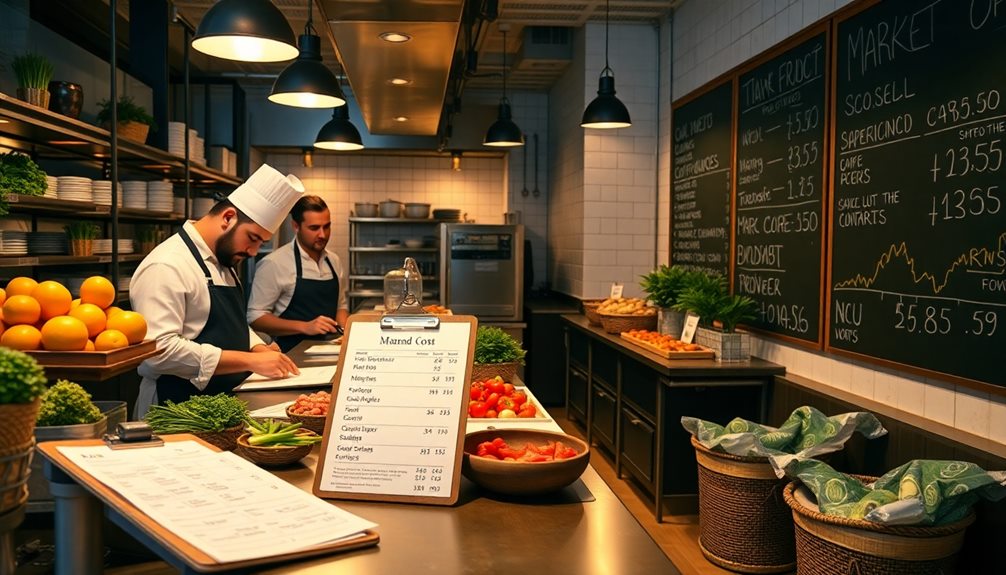
Numerous factors influence how you set menu prices in your restaurant, making it essential to assess each element carefully.
By understanding these factors, you can align your pricing strategy with your business goals and customer expectations.
Here are three key influences:
1. Cost of Goods Sold: Evaluate your prime costs, which include both food costs and labor expenses.
Keeping these in check guarantees profitability while informing your pricing decisions.
2. Target Audience: Understand the demographics and preferences of your customer base.
Tailor your menu offerings and prices to meet their expectations and willingness to pay.
3. Menu Design: Utilize psychological pricing techniques, such as charm pricing and strategic item placement, to enhance perceived value.
A well-designed menu can guide customer choices and facilitate effective price points.
Frequently Asked Questions
How to Calculate Food Cost for a Menu Item?
To calculate food cost for a menu item, determine total raw material costs, then use the formula: Food Cost Percentage = (Total Food Costs / Sales) x 100, adjusting for yield and waste as necessary.
What Is the Most Common Method for Pricing Menu Items?
When pricing menu items, you'll often see restaurants using the food cost percentage method. This approach aims for a balanced cost, ensuring that your prices reflect both quality and profitability while remaining appealing to customers.
What Is a Menu Pricing Strategy?
A menu pricing strategy involves setting prices based on food costs, perceived value, and market demand. You'll want to analyze local competitors and use psychological techniques to enhance customer choices and drive profitability.
What Is the Markup on Restaurant Food?
When you look at restaurant food markup, it typically ranges from 2.5 to 3.5 times the raw cost. This guarantees profit while considering factors like food quality, local competition, and customer expectations.
Conclusion
In summary, when you're pricing menu items, it's essential to blend cost calculations with strategic thinking. You want to guarantee your prices reflect not just the ingredients but also the experience you offer, much like a fine symphony orchestrated for an appreciative audience. By considering psychological pricing techniques and market factors, you can create a menu that resonates with your customers while guaranteeing profitability. Remember, the right pricing strategy can transform your eatery into a culinary hotspot.
